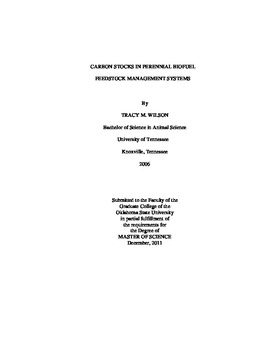| dc.contributor.author | Wilson, Tracy M. | |
| dc.date.accessioned | 2014-04-15T22:06:32Z | |
| dc.date.available | 2014-04-15T22:06:32Z | |
| dc.date.issued | 2011-12-01 | |
| dc.identifier.uri | https://hdl.handle.net/11244/9387 | |
| dc.description.abstract | Demand for alternatives to fossil fuels and the desire to mitigate CO<sub>2<sub> emissions has driven interest in cellulosic biofuel and methods of sequestering carbon (C). Perennial grasses have the potential to meet both of these needs. However, little is known about how management practices influence soil C sequestration and a method is needed to determine changes in C stocks to accurately represent the changes in soil C over time. Soil C storage is expressed as a mass of C per unit area measured to a specific depth. This is not ideal as the soil surface can due to shrink/swell of clays. This can manifest as changes in bulk density. Because many Oklahoma soils have high shrink/swell capacities, their bulk densities may change with soil moisture. Therefore 3 studies were conducted to 1) evaluate the impact of management practices on soil C stocks and 2) evaluate the use of a fixed mass method to calculate soil C stocks in a high shrink/swell soil. In Experiment 1, switchgrass ( Panicum virgatum ), miscanthus ( Miscanthus spp.) and eastern gamagrass ( Tripsacum dactyloides ) were evaluated with harvest frequency to determine the best management practices to achieve energy production and C sequestration in the Southern Great Plains. Soil samples were collected from experiment 2 evaluating 9 switchgrass varieties. The data for experiment 1 showed no difference in soil C stocks between switchgrass, miscanthus, or eastern gamagrass, nor was a difference in C stocks found between harvest frequency treatments. Data from experiment 2 showed that soil C stocks were not proportional to yield. The data suggest that the upland varieties allocate a greater proportion of carbon to belowground carbon stock when compared to the upland varieties. Experiment 3 showed that under moist conditions swelling of clays did not decrease bulk density. On the contrary, moist conditions resulted in compression at discrete depth increments. This compression resulted in increases in bulk density, which increased C stock estimates at these depth increments when fixed depth was used to calculate C stocks. Utilization of a fixed mass method removed this error and provided more precise measurements of C stocks. | |
| dc.format | application/pdf | |
| dc.language | en_US | |
| dc.publisher | Oklahoma State University | |
| dc.rights | Copyright is held by the author who has granted the Oklahoma State University Library the non-exclusive right to share this material in its institutional repository. Contact Digital Library Services at lib-dls@okstate.edu or 405-744-9161 for the permission policy on the use, reproduction or distribution of this material. | |
| dc.title | Carbon Stocks in Perennial Biofuel Feedstock Management Systems | |
| dc.type | text | |
| osu.filename | Wilson_okstate_0664M_11814.pdf | |
| osu.college | Agricultural Sciences and Natural Resources | |
| osu.accesstype | Open Access | |
| dc.description.department | Department of Plant and Soil Sciences | |
| dc.type.genre | Thesis | |
| dc.subject.keywords | biofuel | |
| dc.subject.keywords | bulk density | |
| dc.subject.keywords | soil carbon | |
| dc.subject.keywords | switchgrass | |
